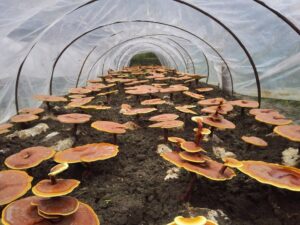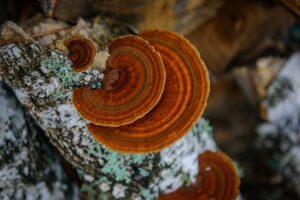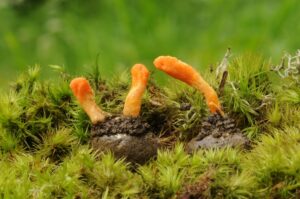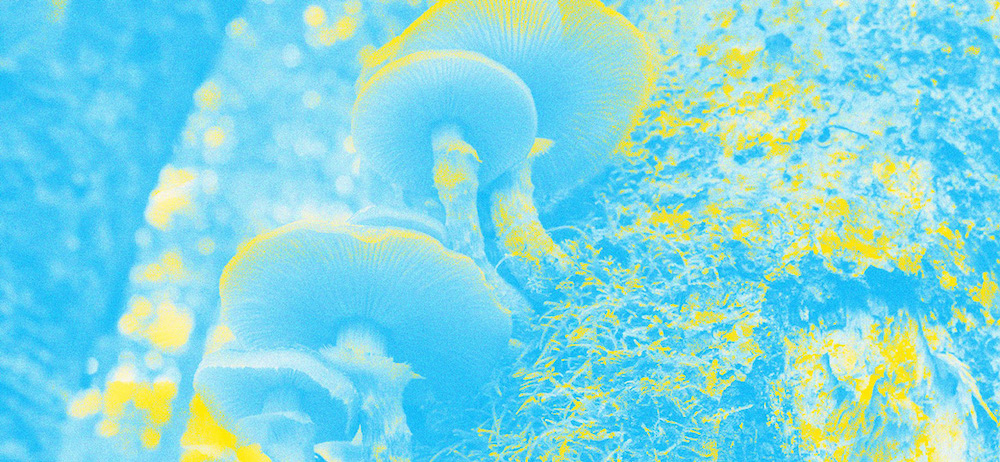Have you ever driven past a mushroom farm? Would you notice if you did? Probably not. That’s because unlike corn or wheat or pumpkins or apples, mushrooms aren’t grown in large, open fields visible to the average passerby. Mostly, they’re grown indoors and undercover, starting their lifecycle not as a seed but as reproductive spores.
Spores galore
“Mushrooms do not sleep,” says Jeff Chilton, a former large-scale mushroom farmer who now runs Nammex, an organic medicinal mushroom extract producer. “All mushrooms are still picked by hand and you literally have to harvest them 365 days a year.” Mushroom farming is a full-time, no-days-off job.

Mushrooms grow quickly — some varieties can double in size in just 24 hours — but they begin life as microscopic spores, individually invisible to the naked eye. Spores can be germinated into pure cultures of the mycelium which is then used to make “spawn.” Depending on the type of mushroom, the spawn is introduced into a food source called a “substrate” which ranges from compost to chopped straw, to wood logs or nutrified sawdust. Some less discriminating mushrooms will even grow on cardboard. Now, once spawned and with the optimum temperature, the root-like mycelium will grow quickly and completely colonize the substrate. “The key to successfully growing mushrooms is to get your substrate colonized as quickly as possible,” advises Chilton, “otherwise there are competitors that will invade and start to eat your lunch and spoil the crop.”
From mycelium to mushroom rings
The tiny white threads that are the mushroom’s mycelium grow underground or into the wood log or sawdust, colonizing it and building energy before producing the stem and cap that is the fungus’ “fruit.” In the wild or indoors, most mushrooms prefer cool and humid growing conditions. Home growers do well to set up their growing trays in a closet or in a deep, covered plastic tote, whereas large-scale mushroom farmers grow inside large, shaded plastic greenhouses.

In nature, mushrooms grow in a symbiotic, parasitic, or saprophytic relationship with their surroundings. Because they contain no chlorophyll, mushrooms don’t feed on sunlight like plants, instead drawing nutrients from tree roots, from decomposing organic matter, or from a living host. One example of a parasitic mushroom is the chaga, which is a fungus that grows on birch trees. Mushroom rings (or fairy rings as they’re more whimsically known) form in a saprophytic manner, feeding on composting material like dead wood, plants, and soil.
Cultivating functional mushrooms
Reishi, cordyceps, and lion’s mane mushrooms are varietals of medicinal mushrooms with one big thing in common: they’re all revered for their health benefits which can range from an improved immune system to a better night’s sleep. “They’re what I’d call preventative medicine,” says Chilton. Growing techniques and conditions between these three mushroom types, however, vary widely.
The simple infrastructure of reishi mushroom farms (shade cloth-covered greenhouses) facilitates the fact that they need to be moved every few years in order to access a continuous supply of clean soil. Live mycelium in sawdust is placed on a hardwood log at which point the colonization process begins. Cultivation of this mushroom starts when sawdust spawn is placed on a hardwood log at which point the colonization process begins. Next, the mycelium-covered log is placed in the ground and buried in a layer of soil casing, keeping the log moist. Growing standards mean that constant pruning is required as just one or two mushrooms are allowed to grow from each log. In the wild, reishi like hot, humid locations. Reishi species are parasitic and saprophytic, choosing coniferous or hardwood trees (dead or alive) as their preferred home.

Cordyceps sinensis presents a more complicated issue for possible cultivation, as the (unwilling) participation of a hibernating caterpillar host is required for their growth in the wild, making it difficult to reproduce the environment on farms. The growing fungal mycelium consumes the caterpillar in a parasitic relationship. In China, where the mushroom flourishes, the government has declared cordyceps a National Treasure — one kilogram sells for approximately $20,000. Fortunately, methods for large-scale cultivation of a similar species, Cordyceps militaris, however, have recently been developed, although climate controlled rooms are required.
Lion’s mane mushrooms grow on decaying trees in a saprophytic set up, thriving in the northern U.S. and Canada. According to a study out of Cornell University’s College of Agriculture and Life Sciences this makes them ideal candidates for forest farming, an ecologically friendly farming method that is both less energy and resource intensive. These beautiful fungi with their cascading mushroom spines can also be grown in artificial conditions, typically out of 4” diameter bags of hardwood sawdust and bran. They’re also a good option for home growers (DIY kits can be easily ordered online).
Caps, gills, volvas and stems
The best part of growing mushrooms? Eating them. “Put mushrooms in your diet!” says Chilton, emphatically. But know this: different parts of the plant, from the root to the fruit, contain different amounts of health benefiting compounds like beta-glucans. All mushrooms, however, are low in calories and high in fibre. So, like Chilton says, put them in your diet ASAP!

